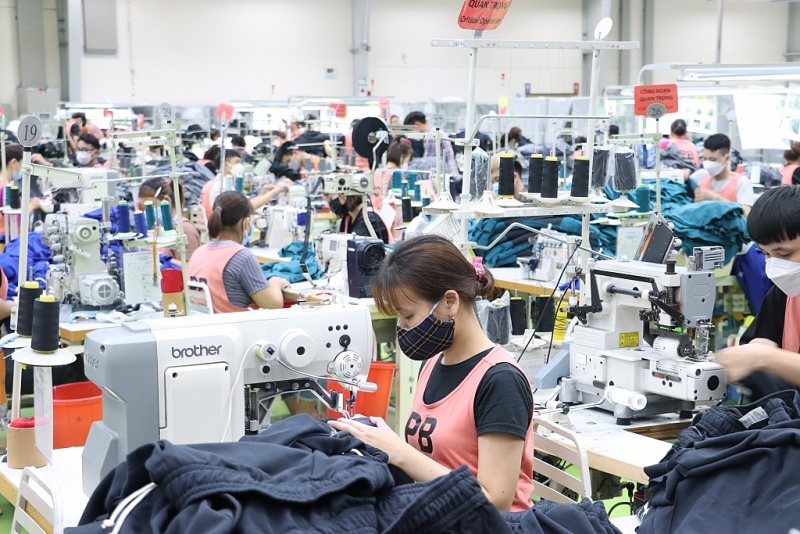Production faced difficulty, raw material import decreased sharply
By the end of September, the country's import only reached US$ 237.33 billion, down 14% (equivalent to a decrease of US$ 38.76 billion) compared to the same period in 2022. In particular, due to difficulties in production of enterprises, import turnover of raw material and auxiliary commodity groups decreased the most.
 |
|
The import-export turnover of the textile and garment sector has decreased sharply from the beginning of 2023 until now. Photo: T.Binh. |
10 product groups reduced by "billions of dollars"
According to new statistics released by the General Department of Customs, by the end of September, 10 groups of imported goods decreased by US$ 1 billion or more.
| From the statistical data of the Customs sector, it shows that the groups of imported goods with a sharp decrease in turnover are related to raw materials and accessories serving the production of exported goods such as phone components, computer components, especially raw materials for textiles, garments and footwear - the field that attracts the most workers in the country with thousands of people. |
The strongest decrease is in the group of all types of phones and accessories. By the end of September, import of this group of goods were US$ 6.05 billion, a sharp decrease of 61.7%, equivalent to a decrease of US$ 9.74 billion compared to the same period in 2022. The main reason is due to a sharp decrease in the Korean market with import turnover in 9 months of only US$ 423 million, while that reached US$ 8.35 billion in the same period last year.
Other sharply reduced commodity groups such as: machinery, equipment, tools and spare parts decreased by US$ 4.04 billion; Plastic raw materials decreased by US$ 2.64 billion; iron and steel of all kinds decreased by US$ 2.03 billion; fabrics of all kinds decreased by US$ 1.86 billion; Other base metals decreased by US$ 1.66 billion; chemicals decreased by US$ 1.57 billion; Auto parts and accessories decreased by US$ 1.37 billion; computers, electronic products and components decreased by US$ 1.14 billion; Chemical products decreased by US$ 1.13 billion.
Thus, the 10 product groups mentioned above alone had a turnover decrease of nearly US$ 27.2 billion compared to the same period last year, accounting for more than 70% of the decline in import turnover of the country in general.
In addition, the notable product group, complete cars of all types, also decreased sharply, while this is one of the sources contributing large budget revenues from import-export activities.
In particular, in the first quarter of 2023, there was an increase of 18,263 units compared to the same period last year, but the second and third quarters of this year decreased by 11,016 units and 27,619 units, respectively.
Strong decrease in raw material group
From the statistical data of the Customs sector, it shows that the groups of imported goods with a sharp decrease in turnover are related to raw materials and accessories serving the production of exported goods such as phone components, computer components, especially raw materials for textiles, garments and footwear - the field that attracts the most workers in the country with thousands of people.
In September, the group of raw materials and accessories serving the textile, garment, leather and shoe industries (including cotton, textile fibres, fabrics of all kinds, raw materials for textiles, garments, leather and shoes) reached a turnover of US$ 2.03 billion, down slightly by 1% compared to the previous month.
In total, for the first 9 months of 2023, import of raw materials and accessories serving the textile, garment, leather and footwear industry only reached US$ 17.77 billion, down 18.1% (equivalent to a decrease of US$ 3.92 billion) compared to the same period last year. before.
The group of raw materials and accessories serving the textile, garment, leather and footwear industry imported into Vietnam mainly originated from China with a turnover of US$ 9.34 billion in the past 9 months, accounting for 53% of the group's import turnover in the whole country, but also decreased by 15.6% (equivalent to a decrease of US$ 1.73 billion) compared to the same period last year.
In fact, the decline in raw materials for manufacturing industries such as textiles, garments and footwear can be understandable when the production activities of most enterprises face difficulties in these two fields.
On October 25, talking to Customs Newspaper, a representative of a large domestic textile enterprise shared that the company's estimated export turnover for the whole year 2023 was only about US$ 300 million. Although still in the group of large export enterprises in the textile and garment industry, this result was only about 70% compared to 2022.
Enterprises' production and export are facing difficulties due to the great impact of many factors such as the impact of the "post-pandemic" Covid-19, instability due to armed conflicts in many parts of the world, and the tightening and changing the shopping habits of consumers around the world...
“Previously, the company's orders and production plans were stable quarterly and annually, but now we have to calculate each week. In the favourable production period, at the end of the third quarter and the beginning of the fourth quarter, orders for next year have been closed, but currently the situation is still very bleak”, the representative of textile and garment company added.
Another difficulty mentioned by the company is that the unit price of processing textile products has also dropped to only 50%-70% compared to before.
To maintain production, the company are trying to implement many solutions, including expanding export markets, especially small-scale markets that have not been paid attention to before.










